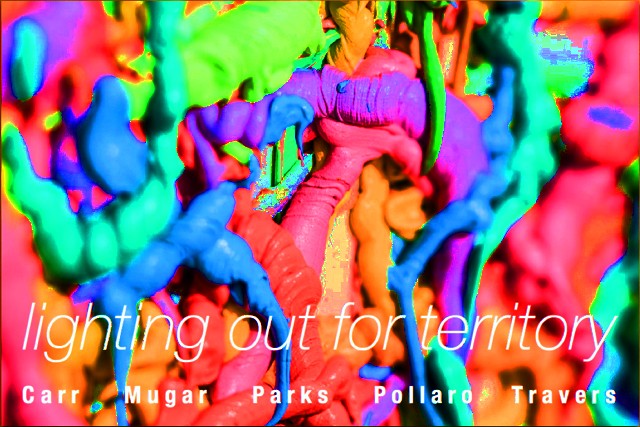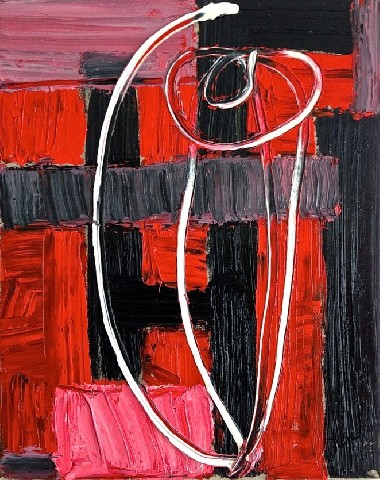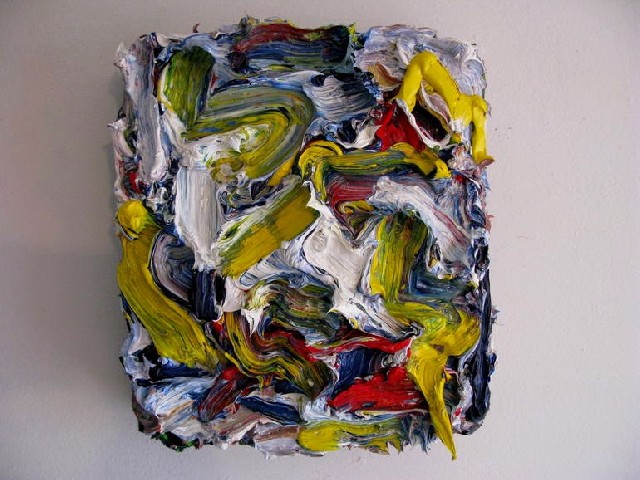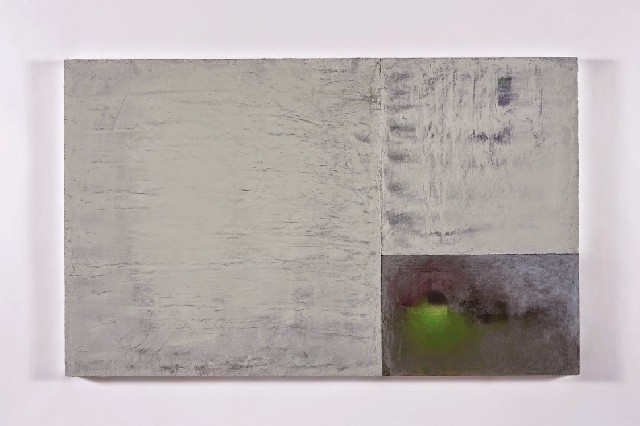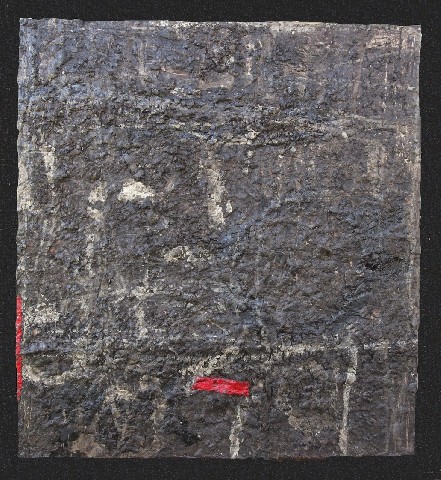Lighting Out for Territory
Group Exhibition at Kimball Jenkins School of Art
By: Martin Mugar - Mar 01, 2015
When the artists in this exhibit exchanged emails with ideas for the show’s title, I had hoped to push a concept involving “topos”, the Greek root of the word topology. I have always had affection for ancient Greek words that embody concepts about the shape of existence such as “logos” or “aletheia”. In taxonomy Latin is used to provide distinct forms, for philosophy Greek provides distinct concepts. When thinking about Paul Pollaro’s work some years ago the word Chthonic, which means “hidden under the earth”, came to mind as a way to encapsulate what his work is about. He liked it. It may be a fallacy in this post-modern world to fall back on words, which evoke essences. But it provides a ground for our thinking; in short a topology, a place to stand on (understanding). So be it. I am not post-modern.
“Topos” didn’t go far in discussion especially when I suggested it should replace painting as the noun to underpin the show. No! We are painters seemed to be the consensus and that was that. I wasn’t going to force the issue. In any case I agree, we are painters first and come out of the world of painting. In our search for a title, I recalled from my high school days the line spoken by Huck Finn at the end of the “Adventures of Huckleberry Finn” that he wanted to “light out for the Territory.” The context was that American Civilization as it was shaped and defined by slavery pre-civil war was pretty murky and Huck thought he needed to flee somewhere to try out new options. That phrase is embodied in American Westerns, which are often set in the unincorporated territories of the West, where conflicting interests were not easily adjudicated as laws were either non-existent or unenforceable. It dawned on me I had injected the notion of “topos” through the backdoor. Territory is derived from terra and is probably the latinate word for “topos”. Artists are always nagged by a need to move out to some new terrain, to not stay put. The “the” before territory got dropped along the way, but that worked as well since artists are not moving out into a specific place but their own psychic plot of ground. Huck’s words struck a chord and stuck.
There is a mixture of buoyancy and alacrity in the phrase. There is also a sense of sneaking off, shirking one’s duties. Both aspects apply to the artists in this show; impatience with the status quo of art, and a letting go of the topics we were told in school were the only route for a serious painter. The artists in this show are New Englanders by choice or by birth, a part of the country known as being overly civilized and cerebral. Tell anybody west of the Mississippi that you come from New England and they will call you an abolitionist or expect you to wear a three-piece suit. I heard from a carpenter who works winters in Arkansas that they like to hire Yankees down there as foremen. They are good taskmasters. We are hard on ourselves too, our own taskmasters. The artists in this show inhabit the same rugged inner psychological terrain as the New England poets such as Dickinson, Frost, Stevens, Eliot, Lowell. Or artists like Hopper, Hartley, Marin.
The original impetus for this show came from a message on Facebook informing me that my painting accepted for the annual “Off the Wall” show at the Danforth Museum last June was hung side by side with Susan Carr’s work. The message said it was a fortuitous paring as both of us work our paint heavily off the surface. I recalled her name from a show curated by Addison Parks in the late Nineties at Crieger-Dane in Boston called “Severed Ear. (the poetry of abstraction)” that brought together the work of New York artists such as Richard Tuttle and Leon Polk Smith with Boston artists such as Tim Nichols, Addison Parks and myself. I went on to Facebook to look up Susan’s work. I could see immediately why we were put side by side. A love of paint but more than that an impulsion of the paint to reach out as though pushed by some energy not constrained by logic. Chthonic seemed to apply here, except it was more the thrust of molten lava than the earth itself.
To select the rest of the participants was not difficult. We are all painters, a distinction that makes a difference these days and moreover we all are in our own way artists who want to put back together what was torn asunder in painting over the last fifty years. We don’t ignore the ideas that motivated that deconstruction but work with them. There is a paring down of art to bare essences in the Greenbergian ethos of painting. And it extends to the point where artists start taking the very material and ground of the painting apart. Where does it end? The work of Kelley, Stella, Ryman, Tuttle and Richter, artists I’d like to label as artists of the ‘bare minimum’, informs our painting. They provide us with the iconic shapes and notions of canvas as sculpture set free by their research into the underpinnings of painting. But our plan is to do something different to them.
So Huck Finn has to light out for new territory, out from the concentration camps of the slave states. Among the artists in this show there is a conviction that the terrain of Modernism that they grew up in, admired, studied and accepted is not the endgame for painting and not to be rehashed ad nauseam. All that was jettisoned from Minimalism: earthiness, anxiety, passion, affection, mystery, magic, surprise, place and space the so-called attributes of the real which were somehow secondary to concepts and ideas come back to haunt the work of these artists. I once seemed perplexed about how personal experience came to inform artwork. You spend time in nature, you move in it, dig in it, touch it smell it, but where and how does it feed into the painting. Addison said it does unbeknownst to you. It is absorbed through your pores, the accumulation of days and nights inhaling the smells of autumn and one day haptically without forcing the issue it pops up in your work. You just let go and it does its magic. The touch and feel of being in the world rejected by the bright lights of logic come back to haunt these painter.
Jason Travers turns “the bare minimum” into a question: ”Is that all there is?” Can this earlier generation of artists proclaim once and for all that an aesthetic broken into parts should be the last statement of painting? For Travers working inside this tradition on panels of pure color or value, each panel becomes an event created patiently over time of endless strokes and marks like someone scratching to escape their enclosure, or insisting that the analytic event that takes apart is important but not more than the abiding presence of the human touch. The multiple panels and the foregrounding of texture are his acceptance and participation in the thinking of the “bare minimum” but at the same time the 19th century of Turner or is it Ryder pops up in certain panels of Travers paintings in part as nostalgia for a bygone world but hints with the slow time of the hand and touch at new notions of time and terrain to light out for. But in the true spirit of a Modernist he raises more questions than he answers.
Addison Parks uses the tradition of abstraction literally as a background for a foregrounded gestural event yet more recently he has foregrounded the abstract pattern. He acknowledges its role in giving to pure colors an iconic force. However, he learned personally from Tuttle’s evolution as an artist that breaking down has to be followed by putting back together. Tuttle, himself, was as much a maker as a deconstructionist: But what forces us to put things back together is life itself. Parks’s work asks in the end: are we just scientists working isolated in our studio/laboratory? If we are alive to nature, our family and those around us in the larger community, then our art must reflect the constant merging and rearranging of our relationships. His works are events, transitory moments of meaning where things fall into place. But any arrangement no matter how ecstatic implies that true to life in the end it can only be transitory.
In a recent blog post I discussed the possibility of painting jumping out of the “enframent” of technology. The word was coined by Heidegger to describe the domination of technology over our thinking about the world. If one accepts the premise that much of modern art has been enframed by the methodological notion of providing simple shapes that are easily recognizable, (Husserl’s eidetic reductions) then the question could arise: how can you get back to the garden where all the reductive parts find their whole again. I discussed this issue in relation to my work and came up with the notion of waiting. Painting not as a power play but as an opening up to possibility. When I began this body of work now in its 15th year, I started not from reduction but multiplicity, a field of colors. All that has initiated change in the work has come about from questions such as: What happens when you use a frosting applicator to create a gesture with volume and smooth surfaces? What happens when you use letters instead of individual marks? The answer to this last question has thrust my painting into the earth/world dichotomy, that Heidegger established, moving it from the earth side of the equation to world side.
Paul Pollaro’s work is in part about the dark light of nature. Not the optical light that lights the world but the energy that radiates from rocks and plants, something that you can pick up with infrared cameras. He has succeeded in pushing the envelope of physicality but most recently the work turned on him in a most unpredictable way. Like Travers and Parks the self-awareness of the paintings presence and language comes from the artists of the “bare minimum” and in particular Richter the master of paint as paint and the canvas as sculptural presence. In his latest work the dichotomy of nature and culture meet in a way that has allowed him to engage the same earth/world dichotomy found in my work. It asks the question: are the abstract constructs of the mind also nature?
In a blog post I wrote about the French painter Jean Helion, I drew a parallel between his prison camp experience in Germany in WW11 that reduced him to a raw unit of labor(arbeit macht frei) and the abstraction that he rejected after the war. All he could think about besides trying to survive during his confinement was the vibrancy of life in Paris. When he escaped and came back to Paris, he abandoned abstraction and embraced figuration in the form of paintings of people in urban settings. I thought of a parallel evolution in style in the work of Stella and Held who abandoned the minimalist trope of their early work to embark in their later years on multifaceted paintings, where there was a complex relation between the parts and the whole. Jean Helion was subjected to a physical and emotional “minimalism” by the Nazi’s. Was the minimalism of abstract art a sort of scientific asceticism in some way parallel to the emotional oppression of life in prison camp? The essence of this show speaks to the primacy of life in the creative process and the topography of time that does not try to crush the spirit but opens up islands to the stream. To borrow the title of Addison Parks’s novel: ”Love and Art, in that order”.
Reposted courtesy of Martin Mugar.

